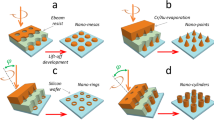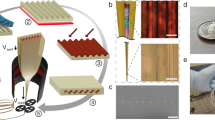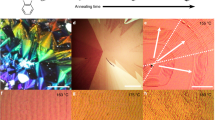Abstract
The wavelength of light represents a fundamental technological barrier1 to the production of increasingly smaller features on integrated circuits. New technologies that allow the replication of patterns on scales less than 100 nm need to be developed if increases in computing power are to continue at the present rate2. Here we report a simple electrostatic technique that creates and replicates lateral structures in polymer films on a submicrometre length scale. Our method is based on the fact that dielectric media experience a force in an electric field gradient3. Strong field gradients can produce forces that overcome the surface tension in thin liquid films, inducing an instability that features a characteristic hexagonal order. In our experiments, pattern formation takes place in polymer films at elevated temperatures, and is fixed by cooling the sample to room temperature. The application of a laterally varying electric field causes the instability to be focused in the direction of the highest electric field. This results in the replication of a topographically structured electrode. We report patterns with lateral dimensions of 140 nm, but the extension of the technique to pattern replication on scales smaller than 100 nm seems feasible.
This is a preview of subscription content, access via your institution
Access options
Subscribe to this journal
Receive 51 print issues and online access
$199.00 per year
only $3.90 per issue
Buy this article
- Purchase on Springer Link
- Instant access to full article PDF
Prices may be subject to local taxes which are calculated during checkout




Similar content being viewed by others
References
The National Technology Roadmap for Semiconductors (Semiconductor Industry Association Report, 1997).
Xia, Y., Rogers, J. A., Paul, K. E. & Whitesides, G. M. Unconventional methods for fabricating and patterning nanostructures. Chem. Rev. 99, 1823–1848 (1999).
Landau, L. D., Lifshitz, E. M. & Pitaevski, L. P. Electrodynamics of Continuous Media (Pergamon, Oxford, 1984).
Amundson, K. et al. Effect of an electric field on block copolymer microstructure. Macromolecules 24, 6546–6548 (1991).
Amundson, K., Helfand, E., Quan, X. & Smith, S. D. Alignment of lamellar block copolymer microstructure in an electric field. 1. Alignment kinetics. Macromolecules 26, 2698–2703 (1993).
Amundson, K., Helfand, E., Quan, X., Hudson, S. D. & Smith, S. D. Alignment of lamellar block copolymer microstructure in an electric field. 2. Mechanisms of alignment. Macromolecules 27, 6559–6570 (1994).
Morkved, T. L. et al. Local control of microdomain orientation in diblock copolymer thin films with electric fields. Science 273, 931–933 (1996).
Thurn-Albrecht, T., DeRouchey, J., Russell, T. P. & Jaeger, H. M. Overcoming interfacial interactions with electric fields. Macromolecules (submitted).
Blythe, A. R. Electrical Properties of Polymers (Cambridge Univ. Press, 1979).
Chou, S. Y., Zhuang, L. & Guo, L. Lithographically induced self-construction of polymer microstructures for resistless patterning. Appl. Phys. Lett. 75, 1004–1006 (1999).
Chou, S. Y. & Zhuang, L. Lithographically induced self-assembly of periodic polymer micropillar arrays. J. Vac. Sci. Technol. B 17, 3197–3202 (1999).
Reiter, G. Dewetting of thin polymer films. Phys. Rev. Lett. 68, 75–78 (1992).
de Gennes, P. G. Wetting: statics and dynamics. Rev. Mod. Phys. 57, 827–862 (1985).
Herminghaus, S. Dynamical instability of thin liquid films between conducting media. Phys. Rev. Lett. 83, 2359–2361 (1999).
Acknowledgements
We thank J. Mlynek for support, S. Walheim for discussions, W. Zulehner and Wacker-Chemie GmbH for the silicon wafers, B. Maile and eXtreme Lithography for the master patterns, and C. Hawker for the brominated polystyrene. This work was supported by the Deutsche Forschungs Gemeinschaft (DFG) through the Sonderforschungsbereich 513, NATO, the US Department of Energy and the National Science Foundation through the Materials Research Science and Engineering Center. T.T.A. acknowledges a research fellowship from the DFG.
Author information
Authors and Affiliations
Corresponding author
Rights and permissions
About this article
Cite this article
Schäffer, E., Thurn-Albrecht, T., Russell, T. et al. Electrically induced structure formation and pattern transfer. Nature 403, 874–877 (2000). https://doi.org/10.1038/35002540
Received:
Accepted:
Issue Date:
DOI: https://doi.org/10.1038/35002540
This article is cited by
-
Towards smart scanning probe lithography: a framework accelerating nano-fabrication process with in-situ characterization via machine learning
Microsystems & Nanoengineering (2023)
-
Electrohydrodynamic instability: effect of rheological characteristics on the morphological evolution of liquid crystal–polymer interface
Bulletin of Materials Science (2020)
-
Influence of high voltage electrostatic field (HVEF) on bonding characteristics of Masson (Pinus massoniana Lamb.) veneer composites
European Journal of Wood and Wood Products (2019)
-
Thermometry of photosensitive and optically induced electrokinetics chips
Microsystems & Nanoengineering (2018)
-
Replica molding-based nanopatterning of tribocharge on elastomer with application to electrohydrodynamic nanolithography
Nature Communications (2018)
Comments
By submitting a comment you agree to abide by our Terms and Community Guidelines. If you find something abusive or that does not comply with our terms or guidelines please flag it as inappropriate.



